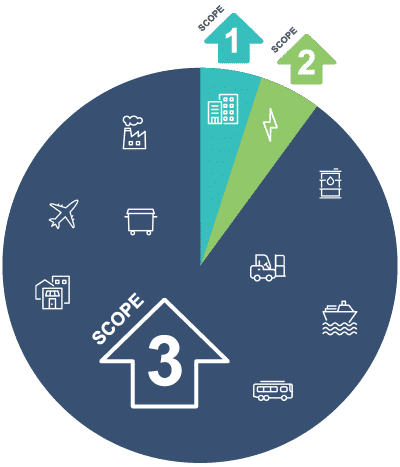What is carbon insetting and how does insetting work?

Companies are diligently working to reduce their direct emissions and energy purchases—known as scope 1 and scope 2 emissions—to meet corporate sustainability targets. However, the majority of emissions for most organizations stem from indirect sources within their extensive value chains, categorized as scope 3 emissions. Carbon insetting emerges as a strategic solution to mitigate these indirect emissions, offering a path to more comprehensive sustainability initiatives.
Carbon insetting allows organizations to finance emissions reduction projects directly within their value chains, offering greater control over their scope 3 emissions. This approach is especially beneficial for companies with significant agricultural supply chains, where there are large opportunities for emissions reductions.
In this guide to carbon insetting, we’ll take a closer look at:
- What is carbon insetting?
- Carbon insetting vs. carbon offsetting
- How does carbon insetting work?
What is carbon insetting?
Carbon insetting empowers companies to actively reduce their scope 3 emissions by funding emissions reduction initiatives directly within their value chain. Essentially, this means companies aren’t merely waiting for suppliers to take action; instead, they’re directly facilitating emission reductions by financing projects that enable their suppliers to avoid, reduce, or sequester greenhouse gas (GHG) emissions.
For instance, a yogurt brand operating on renewable energy might achieve net-zero scope 1 and 2 emissions. However, the brand’s scope 3 emissions stem from dairy farmers—its suppliers—whose agricultural practices produce GHG emissions. Simply changing suppliers won’t address these emissions effectively, as certain value chain emissions are deeply ingrained and can’t be mitigated without altering business practices.
However, the yogurt brand could finance a carbon insetting project to lower emissions from its dairy suppliers, like adopting advanced manure management technologies to curb methane emissions. Carbon insetting offers a practical way to reduce suppliers’ carbon footprints effectively.
Though still emerging, carbon insetting holds particular promise for sectors like food, beverage, and apparel, where supply chain emissions significantly outweigh direct emissions. However, any company can adopt carbon insetting if it identifies opportunities to reduce GHG emissions within its value chain. For instance, technology firms without agricultural supply chains can still contribute by funding their suppliers’ switch to renewable energy, thereby reducing overall value chain emissions.
Carbon insetting vs. offsetting
Carbon insetting differs from offsetting, although both involve financing quantified and verified emissions reductions or removals. The critical difference lies in their implementation: insetting happens within a company’s value chain while offsetting occurs outside.
Consider a US-based snack food company opting for carbon offsets. It might procure carbon credits representing a ton of emissions reduced or removed globally, perhaps by funding reforestation in the Brazilian rainforest. Once the selected credits have been rigorously quantified under a peer-reviewed methodology and certified by a major carbon credit registry, the company might announce its purchase and retirement of the credits, but must do so separately from its reported scope 1, 2, and 3 emissions. Claiming any part of its operations or value chain as ‘carbon neutral’ or ‘offset’ poses a reputational risk, as equating purchased credits’ impact with the company’s emissions may draw scrutiny.

In contrast, carbon insetting involves financing projects that directly reduce scope 3 emissions within the company’s value chain. For instance, a company could financially support its farmers in adopting sustainable practices like cover cropping to enhance soil carbon sequestration. This direct investment not only reduces the emissions linked to sourced ingredients but also directly lowers the company’s reported scope 3 emissions.
In both cases, voluntary corporate investment in emission reductions or removals is positive for the planet and would come with co-benefits for people and nature. However, only insetting allows a company to credibly claim reductions within its value chain and avoid the temptation to use misleading claims such as “carbon neutral.”
How does carbon insetting work?
Carbon insetting works by an organization directly funding emissions reduction projects that others within that company’s value chain implement.
To get started in carbon insetting:
- Ensure a foundation for effective claims and program impact through an analysis of your scope 3 reporting and data collection capabilities.
- Develop an action plan that will guide your insetting process. This includes decision making around the quantification approach, risk management, supplier involvement, and budgeting requirements.
- Select projects within your supply chain for investment based on your criteria with the help of 3Degrees.
- Implement rigorous reporting and verification processes to ensure interventions are credible and defensible.
- Claim the GHG and non-GHG benefits following your objectives.
Sometimes measurement and verification take the form of quantifying impact by generating credits (the same way the voluntary carbon market quantifies impact), though these credits are retained for insetting purposes rather than sold outside the supply chain. Alternatively, insetting might rely on precise emissions measurements without a formal credit registration process. In both scenarios, safeguards should be in place to defend claims and prevent double-counting of emissions benefits.
3Degrees has a long history of helping brands understand their value chain emissions and create clear carbon roadmaps for both short- and long-term climate goals. Our full-service project development capabilities, including quantifying the benefits of a wide range of technologies in line with widely recognized methodologies, enable us to work with you to create custom carbon credit projects, including insetting interventions, that reduce project risk and deliver results in line with your goals.
If you’re interested in exploring how insetting can advance your scope 3 emissions reduction goals, we invite you to contact us. Let’s discuss how we can support your sustainability journey.
FAQs
Want some quick information about carbon insetting? Take a look at these FAQs:
What are the benefits of carbon insetting?
Carbon insetting not only targets the reduction of scope 3 emissions within the value chain but also fosters environmental and social enhancements. Benefits extend to improved financial stability for agricultural workers and communities, enhanced biodiversity, better air quality, and healthier soil conditions, contributing to a more sustainable ecosystem.
What is an example of carbon insetting?
Insetting can be implemented wherever emission reduction opportunities exist within a company’s value chain. A notable example is the adoption of regenerative agricultural practices, such as agroforestry, which combines trees and crops to boost carbon sequestration and can also enhance farm productivity. 3Degrees is pioneering insetting initiatives, including innovative projects like vermifiltration systems that use worms to process cow manure, significantly reducing GHG emissions.
What types of companies are doing carbon insetting?
Companies across various sectors with significant value chain emissions are exploring insetting. Early adopters typically include those in industries where supply chain emissions dominate, such as the food and beverage sector and the apparel industry. These companies are leveraging insetting to address their environmental footprint proactively.


